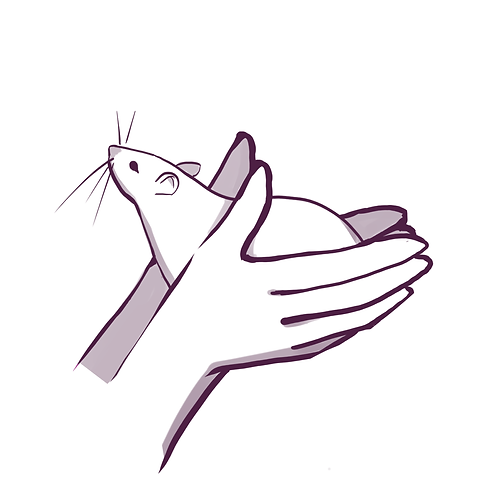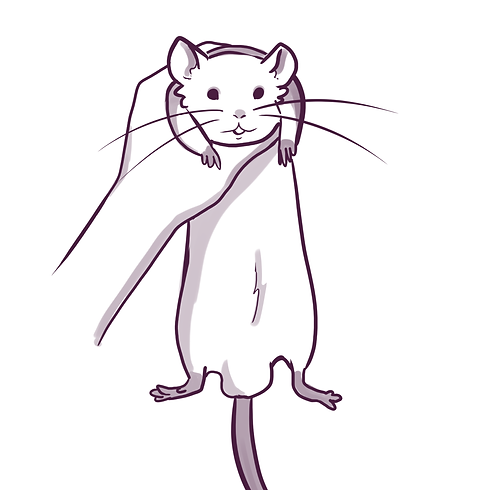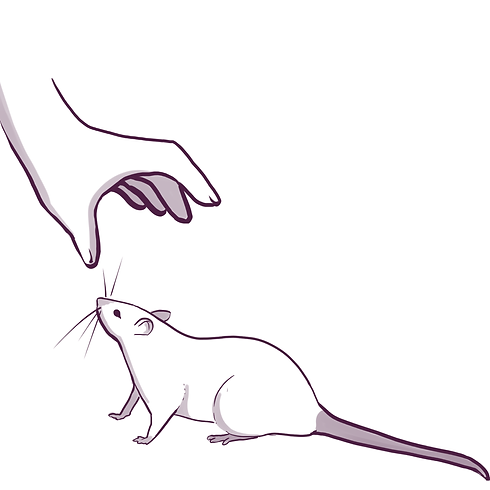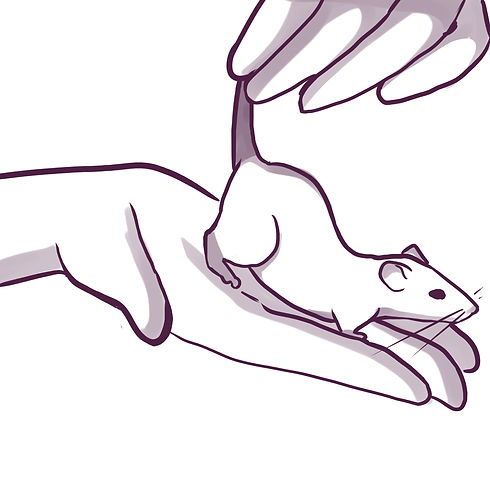HANDLING AND BONDING
HOW LONG SHOULD I WAIT BEFORE HANDLING NEW RATS?
There is no one size fits all for this. Some rats are cool with handling straight away, some are not. You will often hear things like “ leave them alone for the first 1-3 days”, but there is no point in waiting to handle and get familiar with your rats for that long if they are well behaved and seem comfortable. If your rats aren't super skittish and terrified, handling them and getting them used to you straight away is beneficial! If you do have very skittish and scared rats, it's good to let them be and allow them to settle overnight so they learn that their cage is their home and that's where they're safe. There are a few things to remember when working with skittish rats of any age; respect their boundaries, have patience, do not approach them from above, avoid sudden quick movements, do not remove hides while they're sleeping in them as this can spook them quite a bit. Having a lot of open space in your cage can make skittish rats even harder to work with due to them being prey animals, and by instinct feeling unsafe when exposed.
Rats from us are temperament tested, and can be handled straight away.
MY RATS RUN TO GREET ME, BUT ALWAYS RUN AWAY FROM MY HAND WHEN I TRY TO PICK THEM UP, ANY TIPS?
Let the rats sniff you, especially if they're not familiar with you just yet. You want to avoid approaching the animals from above if they're not fully comfortable around you. Rats are prey animals, so its instinct to run away from something approaching from above, think of it as bird talons approaching. Treats are a great way to bond with your rats and get them comfortable. Liquid treats work fantastic as they cannot really take it and just run away. You can place some baby food on your fingers or a spoon and let the rats lick it off, this will help them associate your hands with good things. Do not do this through the bars. Only from an open door, or when the rats are out and about from the cage. You can also pick up a rat, and simply put it down and give it a treat, and keep repeating this and once this is going smoothly, you can change it to picking up, give a treat while you're holding the animal and then put it down. Eventually this will advance to the animal eating a treat while being held or sitting on your hand.
WHAT ARE THE BEST WAYS TO BOND OUTSIDE THE CAGE?
Pockets, bonding pouches, hoods and shoulders are some of the most popular ways to bond with your rat outside of the cage, all these will allow you to have the rat on your person. Having the rat with you while watching TV or working on the computer is a nice way to spend time with your rats without having to set up a whole play pen or have all the rats out at the same time. Please do NOT have the rats on your person when cooking, this can be extremely dangerous as people have had their rats just skydive into hot oils and water. For more timid rats, being able to hide into a pouch or a pocket for example, will make the experience a lot more comfortable and eventually they will crawl out on their own to explore as they grow more confident. Many rats don't accept treats outside the cage at first, but this doesn't mean you can't offer them. If they don't accept a treat outside the cage, don't get discouraged or worried, when they'll feel more confident and comfortable with being out of the cage, they will start accepting treats as normal! Open space, once again, can be intimidating to more timid rats, so having a hoodie pocket, blanket or some other hiding place is important! Some rats don't care and will go on magical adventures straight away.
DOS AND DON'TS OF PICKING UP YOUR RAT

THE SCOOP
Do
Scooping your rat from below is a pretty straight forward way to pick up the animal, this is the best way to pick up new or skittish rats. From the scoop you can easily hold the animal with two hands, this is especially fun with tiny rats as they will fit in very snug and you can even cup one hand over the rat to create little hide out. This works for all ages and sizes, this is especially good with young timid rats and old fragile rats who need their body supported more.

THE DANGLE
Do
This is a hold you will become very familiar with very fast. You will see it a lot online and use it yourself! You do this by picking the rat firmly from its upper mid section, either from below, or if the rat is fully comfortable with you, from the above. This hold is very good when giving your animal a quick health check as you will be able to see the under side of the rat very easily. If your rat is very wiggly in this hold, try placing your other hand under it's feet, this should make them feel more secure.

GRAB FROM ABOVE
Situational
Grabbing your rat from above is perfectly fine when the rat is comfortable with you, but with more skittish rats this can really spook them. In the end rats are prey animals and skittish rats will bolt it when something approaches from above due to instinct. A rat who is comfortable with you will let you grab them from above without any problems, knowing your rat is very important! When your skittish rats are getting more used to handling you can place your hand on them from above while already holding them, this should help normalize a hand approaching from above.

RESTRAINT HOLD
Situational
This is a hold you won't often need, most won't ever need this in fact. This will mainly be used with uncooperative rats when having to check the underside of their bodies for injuries, mites, lumps or penis plugs for example. Hold your rat from behind with your index finger on one side of the head and your middle finger on the other side, the rest of the fingers should be wrapped around the upper section of the torso under the arms. Place your other hand under the rat's feet to make it feel more stable and secure. Make sure your hold is firm, the rat will know if you're hesitating and will wiggle its way out.

BY THE TAIL
Don't
You might have seen mice in labs or shows being lifted by the very base of their tails; this shouldn't be done with rats, especially adults due to their weight. Grabbing a rat by its tail can cause it to degloved. Degloving is a defense mechanism in rats that causes the upper layer of skin and tissue to be sheared or torn away from the bone. This can happen when the rat is picked up by the tail, or for example, when the tail is caught between the cage door. This injury is not only painful to the rat, but leaves the exposed area open to infection. If your rat does suffer a degloving injury, take them to the vet. In mild to moderate cases, the tail will be cleaned and the animal put on antibiotics to prevent infection. In severe cases the tail will have to be amputated to prevent serious complications.
If there is an emergency situation, where catching your rat immediately will be a question between life or death, it is better to cause an injury than to have the animal die. If the only part of the body you can grab in an emergency is the tail, try to grab it from the very base, the part closest to the butt. This will minimize risk and severity of possible injuries caused by being grabbed by the tail
